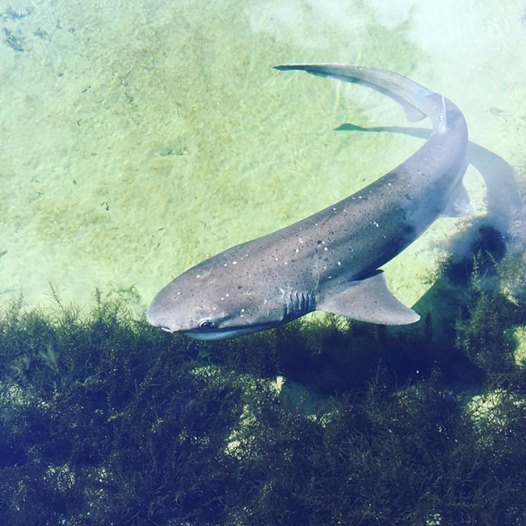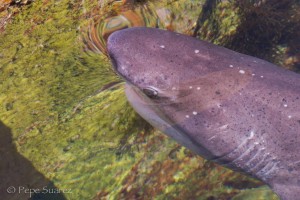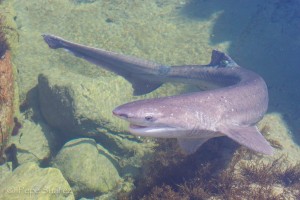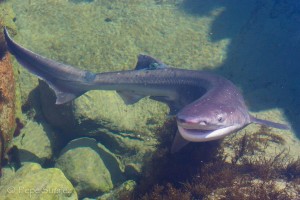
Seven gill shark tagging and use of accelerometer
Posted by Jamie Halkyard and Megan Peterson on January 27, 2016
Catch, tag and release alive sevengill sharks (cowsharks) with accelerometer
Seven gill sharks are one of the most unknown shark species in temperate coastal waters of South African. Ebert (1996) conducted a study of these sharks in this area and found that males have viable sperm year-round indicating they may be able to reproduce at any time of the year and that mature males are between 140-160cm (Ebert 1996). Williams et. al. (2012) studied sevengill shark movements using acoustic transmitters and found that size and sex are important factors that influence the timing and patterns of their abundance in particular areas in estuary embayments around the north-east Pacific Ocean.
During our time interning at Oceans Research in Mossel Bay, we had the privilege of witnessing acoustic tagging of seven gill sharks - Notorynchus cepedianus =. We went out with field specialists on four occasions to two sites across the South African coast.
On our first trip (17th of September 2015), we left with the full team including Enrico, Olivia, Justin, Ryan, Dylan, Ralph, and us interns (Claudia, Jamie and Megan) and arrived around 2.30pm to find local fisherman Shawn Mey who runs his own extreme fishing tours. Shawn told Oceans that many male seven gill sharks were being caught at this site this time of year. We were led down through rock cliffs to a natural pool where a seven gill shark was being held for observation in preparation for eventual tagging. However, before this shark could be tagged another seven gill shark was caught on the other side of the rock cliffs where the fishermen were set up, and we arrived to find that the team had placed it into tonic in a shallow rock pool and the tagging process was about to begin.
We were able to observe our first live tagging procedure starting from the incision, acoustic tag insertion, stitching, antiseptic powder being sprinkled on and then being splashed with water to seal the cut, to the eventual release of the shark back into the water safely. We then returned to the seven gill in the holding pool, filming and observing its behaviour for 20 minutes before being joined by the rest of the team to observe the tagging process. We watched as Shawn transferred the shark to a nearby sandy shallow pool which was an easier location to hold and tag the shark. The shark was then observed for other 20 minute post-tagging period. Both of the seven gill sharks caught and tagged were males.
Our second trip was the following day and at the second site - inside a private nature reserve. On arrival we saw Shawn and all of his fishing gear was set up and we were hoping he would catch more seven gill sharks for the acoustic tagging procedure. While we were waiting for a catch we took the time to explore the surrounding vegetation and rock pools. Once Shawn did hook and land a seven gill shark, we got the go-pro ready for filming the procedure from start to release, while Enrico timed and recorded details about the total time the shark was out of the water, how long the operation itself took, and important data about the shark including its pre-caudal length, total length, and the level of calcification of the claspers.
It is currently spring here in South Africa which is an interesting factor to consider. Ebert (1989) studied sevengill sharks around Californian coastal waters and concluded that these sharks have a spring-summer breeding season based on characteristics of the gonads, egg size, development of the embryos and scarring on adult individuals. Although the acoustic tagging program has just started here, we were able to observe field specialists discussing the level of calcification of the claspers which is one of the most common methods that can be used to externally determine sexual maturity in male sharks (Awruch et. al., 2008). During our time observing the team, we were able to see the different levels of calcification of a couple sharks and sometimes red scratches indicating that they have potentially already mated (Ebert, 1989). We also observed field specialists measuring the sharks’ pre-caudal and total lengths. A study of sevengill sharks caught through recreational fishing in Argentina found that males reach maturity at a total length of 170cm and females at 224cm (Lucifora, L. O., Menni, R. C., & A. H. Escalante; 2005).
Between our second and third trips, an accelerometer was placed on the shark to assess the energy expenditure (as proxy for stress) as the shark moved through the water. The idea was to catch it, put immediately an accelerometer, and record the next 24 hour behavioural patterns, including post-catching recovery pattern. Then insert a transmitter into the peritoneal cavity and monitor the next 24 hour post-tagging recovery pattern. The acoustic transmitter was implanted on the dorsal fin. Each hour we collected data on environmental variables as well as the behaviour of the shark.
Literature also indicates that prey abundance across different shark lengths is important. After dissecting sevengill sharks, Lucifora, Menni & Escalante (2005) found that the diet of these sharks relates to their size, with smaller sharks (less than 100cm) eating mainly telosts (bony fish), whereas sharks between 100-170cm eat less teleosts and mostly cartilaginous fishes and larger individuals (170cm and above) eat mainly cartilaginous fishes and marine mammals. Ebert (2002) analysed the stomach contents of sevengill sharks in South Africa and California to determine whether differences in diet occur in correspondence with size and sex. He also found that teleosts are common across the diets of smaller sevengill sharks with cartilaginous fishes and marine mammals becoming more common with larger sharks.
Having the opportunity to be out in the field observing the Oceans Research team with their project on sevengill sharks enabled us to gain important practical skills and knowledge that is rarely offered at university. This was an unforgettable experience and will be invaluable for our future endeavours in contributing to the current understanding of sharks.
References
-Awruch, C. A., Frusher, S. D., Pankhurst, N. W., & J. D. Stevens. (2008). Non-lethal assessment of reproductive characteristics for management and conservation of sharks. Marine Ecology Progress Series 355: 277-285.
-Ebert, D. (1989). Life history of the sevengill shark, Notorynchus cepedianus (Peron 1807), in two California Bays. California Fish and Game 75: 102-112.
-Ebert, D. (1996). Biology of the sevengill shark Notorynchus cepedianus (Peron, 1807) in the temperate coastal waters of southern Africa. South African Journal of Marine Science 17: 93-103.
-Ebert, D. (2002). Ontogenetic changes in the diet of the sevengill shark (Notorynchus cepedianus). Marine and Freshwater Research 53: 517-523.
- Lucifora, L. O., Menni, R. C., & A. H. Escalante. (2005). Reproduction, abundance and feeding habits of the broadnose sevengill shark Notorynchus cepedianus in north Patagonia, Argentina. Marine Ecology Progress Series 289:237-244.
- Williams, G. D., Andrews, K.S., Katz, S. L., Moser, M. L., Tolimieri, N. Farrer, D.A. & P. S. Levin. (2012). Scale and pattern of broadnose sevengill shark Notorynchus cepedianus movement in estuarine embayments. Journal of Fish Biology 80: 1380-1400.


